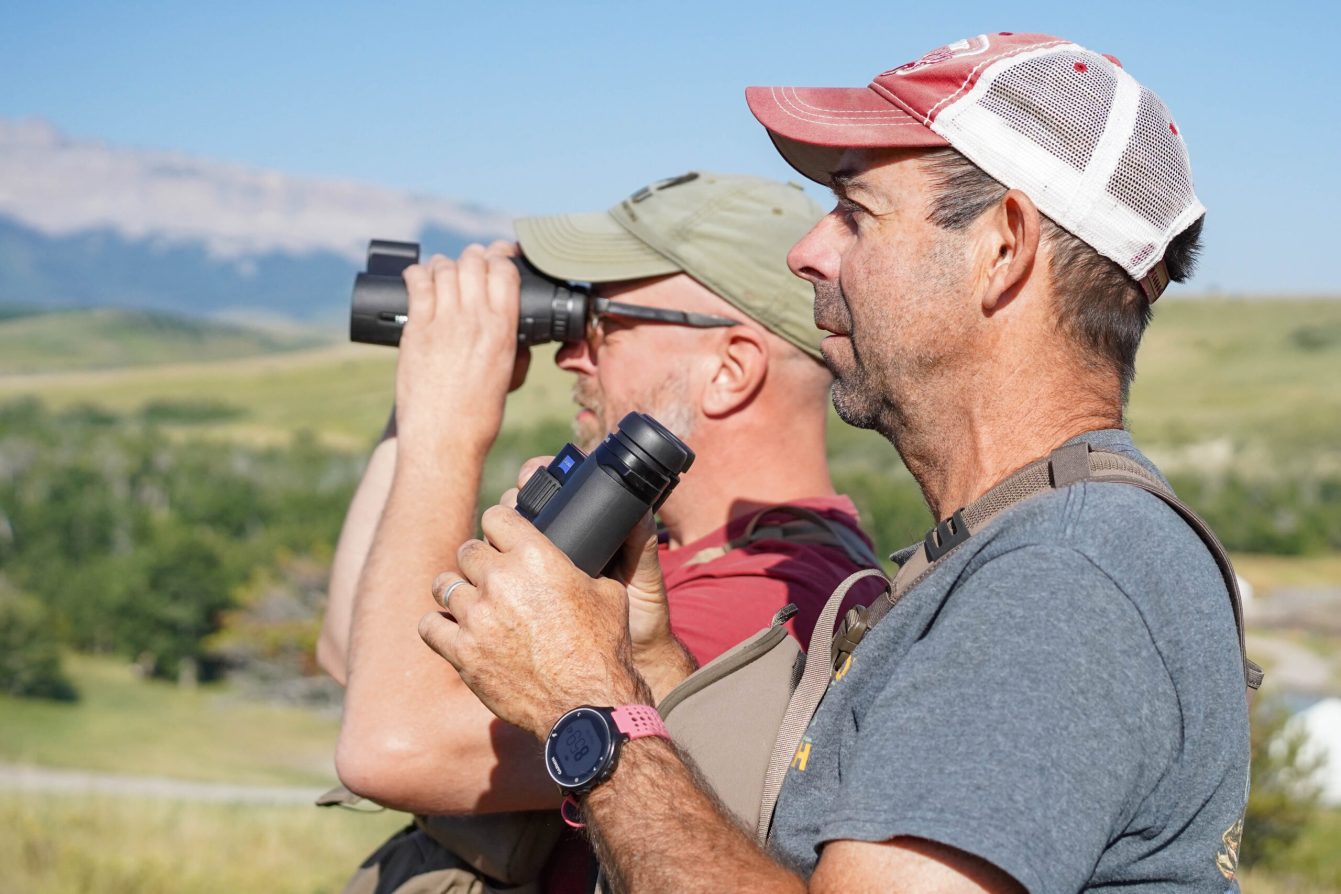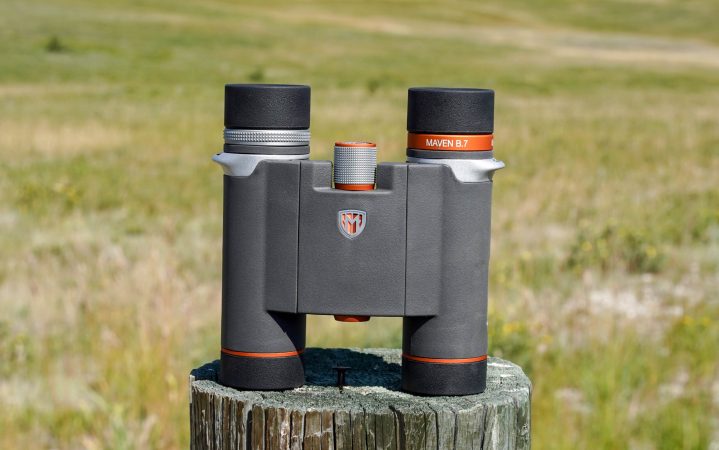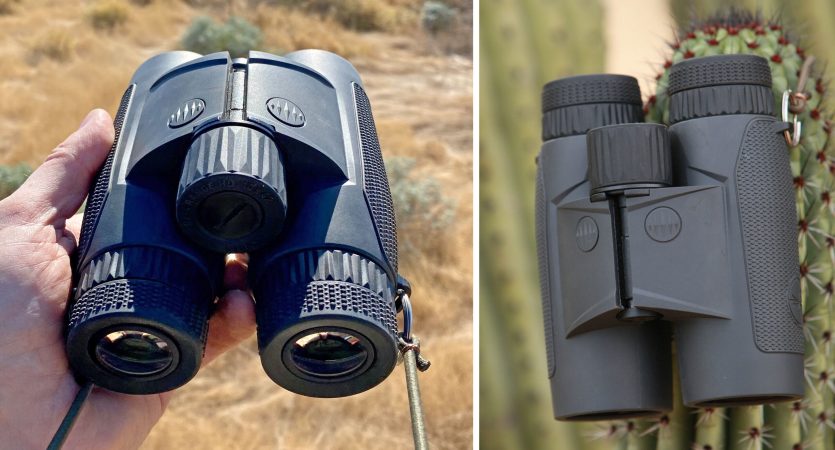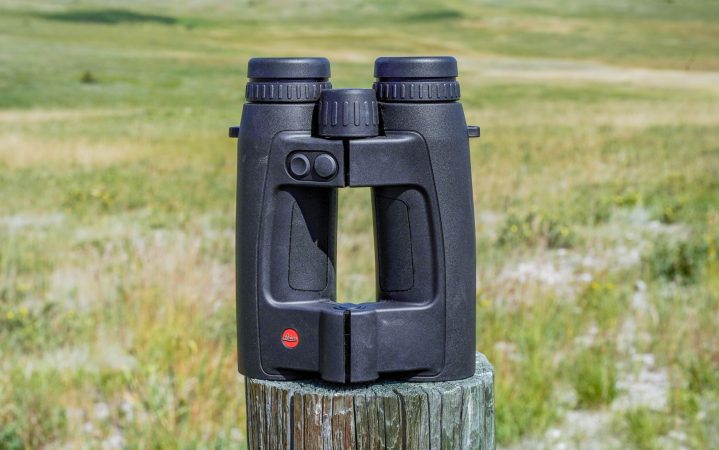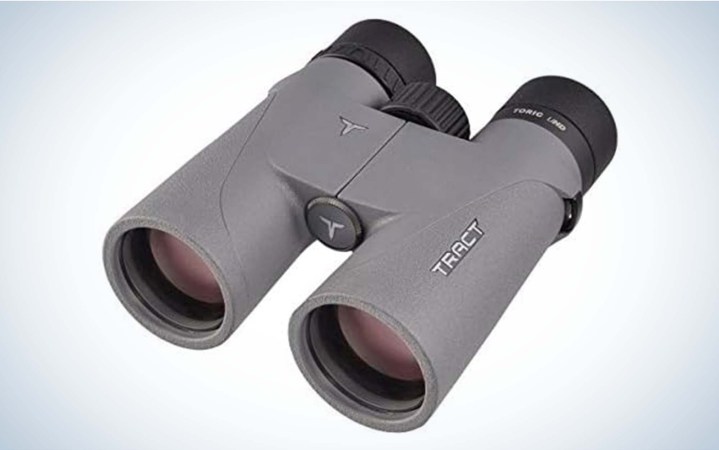We may earn revenue from the products available on this page and participate in affiliate programs. Learn More ›
Even after peering through thousands of models, binoculars still amaze me with their magical capability to reveal hidden worlds. How else can you describe the knowledge you gain by viewing and identifying a distant bird, but also notice fine details in its plumage and expression?
For hunters, a good binocular will save many miles of hiking, owing to its ability to compress distance and verify if that far-away buck is worth the walk.
Binoculars belong in every pickup truck console, kitchen window sill, and around every hiker’s neck in order to positively identify distant objects, inspect close-up insects (and sometimes the fine print on roadside history signs), and to make your world larger, wider, and more interesting.
While binoculars share many attributes—parallel magnified tubes governed by a common focus control—they’re more different than their generic appearance might suggest, and their wide variation complicates buying decisions. Do you prioritize magnification, or field of view? Do you want a durable closed-bridge bino, or a more nimble open-barreled design? Do you need an integrated laser rangefinder, or is low-light capability more important to you?
This review is designed to help you answer those questions in order to find the best binocular for your specific combination of use, mobility, and budget.
The Best Binoculars
- Best Overall: Swarovski NL Pure 10×52
↓ Jump to Review - Best Value: Vortex Triumph HD 10×42
↓ Jump to Review - Best Compact: Zeiss SFL 8×40
↓ Jump to Review - Best Pocket Size: Maven B.7 8×25
↓ Jump to Review - Best for Bowhunting: Vortex Razor UHD 8×32
↓ Jump to Review - Top Binocular Innovation (Form-Fit Eyecups): Leupold BX-4 Pro Guide HD 10×42 Gen 2
↓ Jump to Review - Best Entry-Level: Hawke Frontier ED X 8×42
↓ Jump to Review - Best for $400: GPO Passion SD 10×42
↓ Jump to Review - Best Budget: Bushnell R5 8×42
↓ Jump to Review - Best Value Truck Binocular: Riton 5 Primal
↓ Jump to Review - Best Rangefinding Binocular: Leupold BX-4 Range 10×42
↓ Jump to Review - Best Ballistic Rangefinding Binocular: Leica Geovid Pro 10×42
↓ Jump to Review - Best Mid-Priced Binocular: Tract Toric UHD 10×42
↓ Jump to Review
The Best Large-Frame Binoculars (Jump to this section)
- Best Overall: Swarovski NL Pure 14×52
↓ Jump to Review - Best for Long-Range Shooting: Maven B.5 MOA/MIL 18×56
↓ Jump to Review - Best for Hunting: Vortex Razor UHD 18×56
↓ Jump to Review - Best Image Stabilized: SIG Sauer ZULU6 16×42
↓ Jump to Review - Best Rangefinding: Leica Geovid R 15×56 LRF
↓ Jump to Review - Best Innovation: Leupold BX-4 Pro Guide HD Gen2 12×50
↓ Jump to Review - Best Entry-Level: Bushnell R5 12×50
↓ Jump to Review - Best Budget: Hawke Vantage 12×50
↓ Jump to Review
How We Tested the Best Binoculars

We put all submissions to our annual binocular test through the same criteria. First, we measure optical resolution, using the diminishing black-and-white lines of a 1951 Air Force Resolution Target to score the optical performance of each submission. We also measure the low-light performance of each binocular by mounting them to tripods and focusing them as a group at 200 yards at a black-and-white resolution target starting at twilight and then well into the gathering dark, all in order to measure the brightness of the glass. This is an important consideration for both hunters and wildlife watchers, since animals are more visible in the early morning and late evening than at any other time.
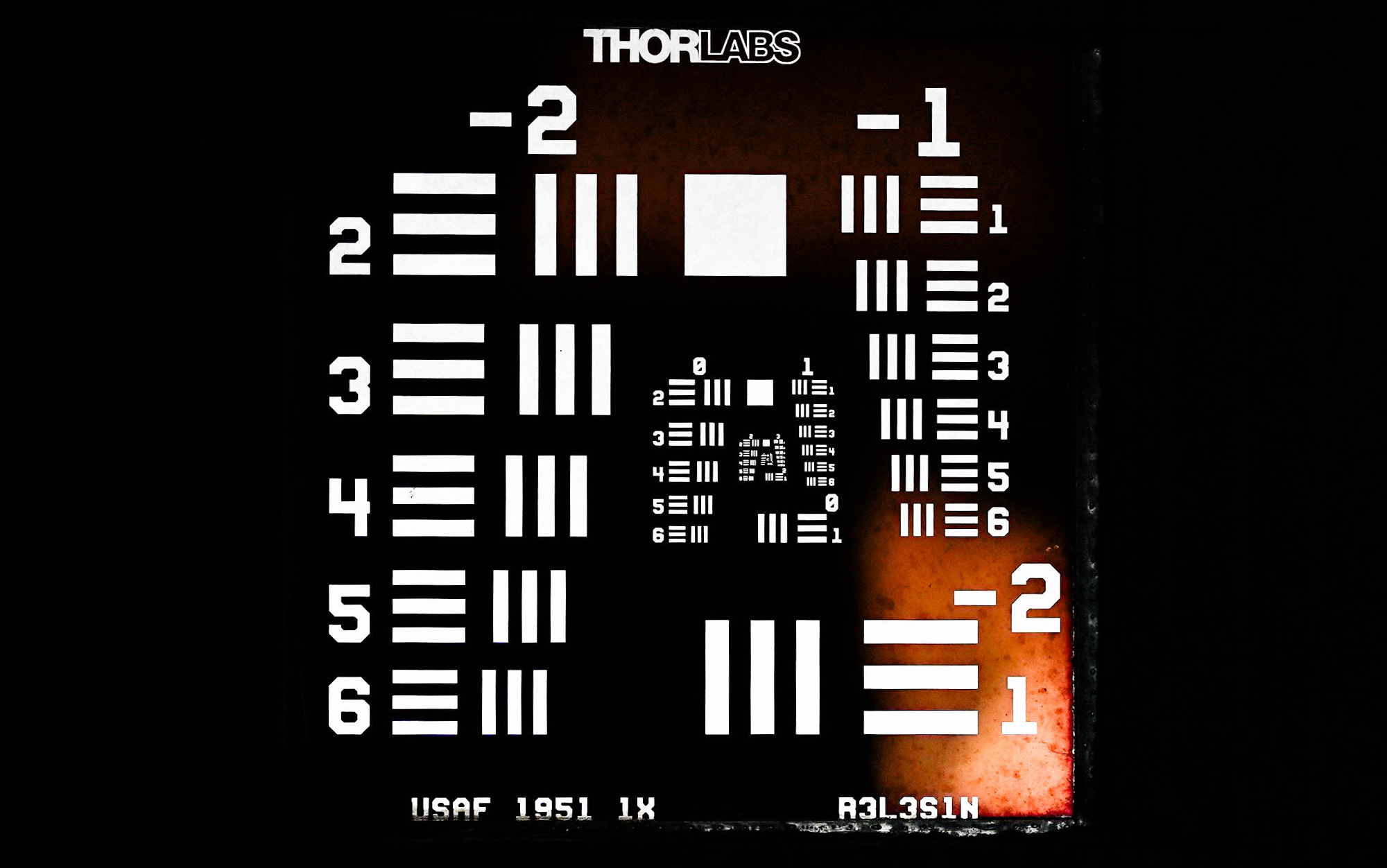
The binocular that can “see” the longest into the dark gets top marks. The model that loses its night vision earliest gets the lowest score. Binoculars in the middle receive weighted scores somewhere between those two poles. We averaged the results over at least three nights, with a different pair of eyeballs behind the binoculars each night, to arrive at our adjusted score.
How We Scored the Results
We break our 10-point scoring into four general categories: optical performance, mechanical performance, design, and value. The average of these categories is the basis of our grades, detailed below.
Optical performance includes the resolution and low-light tests plus the more subjective assessments of image quality and brightness. Mechanical performance assesses the durability of the submission along with its controls: focus and diopter controls, eyecup extension, and comfort. In the case of rangefinding binoculars, it also factors the electronic interface and performance. Design considers the exterior finish, interior blacking, tripod mount, and its innovation and versatility, along with its comfort. We ask testers to evaluate this critical question: how long could you glass with this binocular?
And then our price/value score rates how much optic—along with warranty and amenities such as carrying case or harness—you get for your money. The binocular that gets the highest overall score wins our Editor’s Choice award for the best in the category; the optic with the highest price/value score wins our Great Buy recognition.
For some members of this roundup of binoculars, we are using test results from previous years, but we tested most of these entries in our big 2024 test of binoculars for hunting, budget binoculars, and rangefinding binoculars.
Our 10-point evaluation adds up to a total numeric score, but we translate those to grades for each submission. The optical performance grade combines the scores from resolution, low light, image, and brightness. Our mechanical performance grade aggregates the mechanics and durability score. The design grade considers construction, innovation, versatility, and comfort. And then the price/value grade is our value grade.
To earn an “Excellent” grade, the average of that category must be 9 or higher, which is extremely hard to achieve. “Very Good” is an average score of 7 to 9. A “Good” grade is 5 to 7. Our “Fair” grade is 3 to 5, and “Poor” is anything under 3.
Best Binoculars: Reviews & Recommendations
Best Overall: Swarovski NL Pure 10×52
Score Card
- Optical Performance: Excellent
- Mechanical Performance: Excellent
- Design: Excellent
- Price/Value: Good
Key Features
- Wasp-waist, open-barrel design
- Center-wheel diopter control
- Oversized focus wheel
- Field of View: 426 feet at 1,094 yards
- Also available in 32mm and 42mm models
- Weight: 36 ounces
- Price: $3,449
Pros
- Premium field-flattener lenses
- Tapered tube design enables shake-free holding
- Premium glass and coatings
- 10-foot close focus
- Lightweight
Cons
- At $3,449, a wildly pricey binocular
- Non-locking diopter
- Tripod mount sold separately
Once you recover from the sticker shock of this Austrian-made binocular, find a way to experience the image and the design that starts to justify its price of $100 per ounce. In terms of image quality, low-light performance, and ergonomics, the NL Pure is one of the most remarkable binoculars Outdoor Life has ever tested.
Its distinctive external lines are purposeful. Swarovski introduced the roof-prism NL Pure four years ago in three configurations: 8×42, 10×42, and what seemed like a crazy magnification at the time, a 12×42. That high-power binocular works as a shake-free hand-held optic because of its balance and the balance-enhancing barrel shape.
This year the Austrian optic company is extending the line with a series of 52mm binos. The 14×52 version is in our large-frame binocular test, and requires stabilization to perform to its potential. The 10×52 is a better balance of hand-holdability, image delivery, and overall handling.
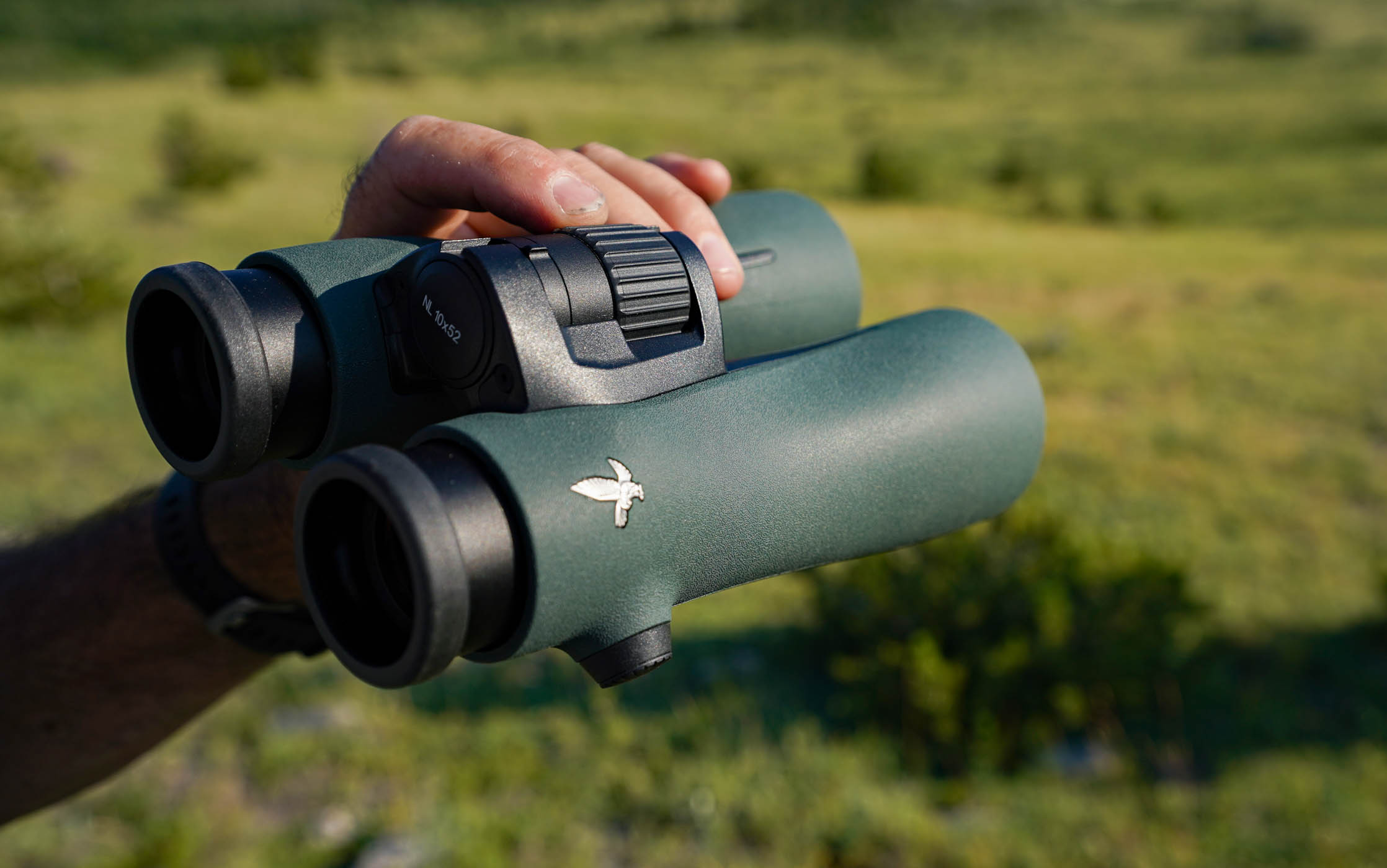
Scott Einsmann
Swarovski calls the NL Pure a “wasp-waist” design, and a new optical prescription and redesigned prism allow the chassis to accommodate big objective lenses, a slender mid-section, and large eyepieces fitted with field-flattener lenses that enhance edge sharpness. The design also enables a monstrous field of view. The 10-power NL Pure has a 426-foot FOV at about 1,100 yards (the strange math is because I’ve converted from metric meters). That’s even wider than most 8-power binoculars, and far wider than any other 10-power that we’ve tested. If you’re a glasser that appreciates panoramic images and the ability to take in wide swaths of landscapes, the NL Pure is for you.
This binocular is decidedly not for you if you want to mount it to a standard tripod. One of the more frustrating aspects of Swarovski’s design is its proprietary front-hinge tripod socket. Instead of being fit with a standard ¼-20 thread, the NL Pure has a special click-lock socket that only accepts Swaro’s tripod mount, which sells for an additional $200. A cheaper alternative is to buy the $60 NL Pure adapter at Outdoorsmans and install it yourself. But either way, it’s an affront to working-class glassers to have to buy an aftermarket tripod mount after spending $3,500 on the binocular.
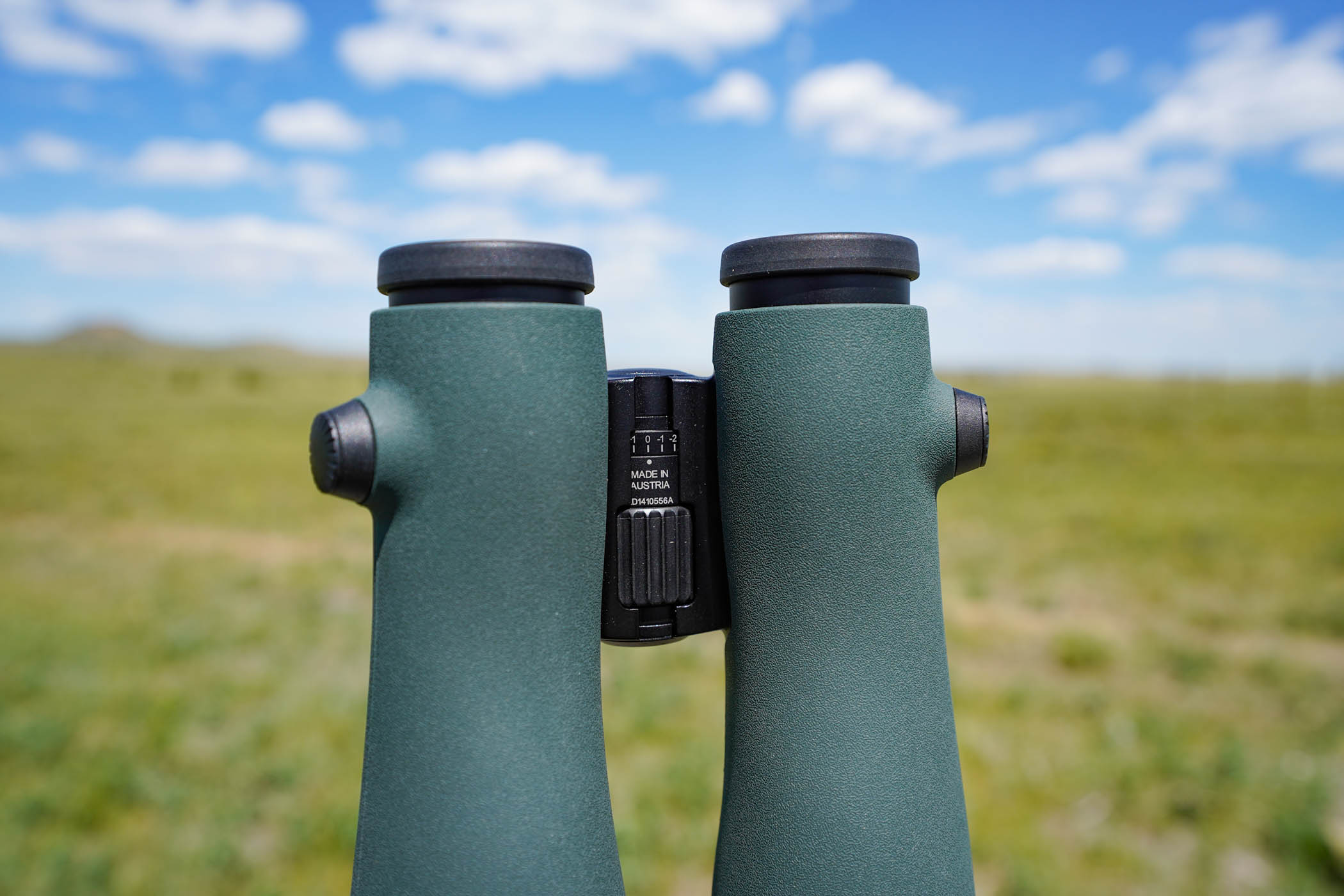
Testers also dinged the NL Pure for its non-locking center-dial diopter, which features a tab that can easily get bumped off plumb, especially if users employ enclosed bino harnesses. Evaluators had mixed reviews of Swaro’s proprietary harness mounting system, which features push-to-turn locking studs that hold straps to the chassis. The system, while elegant, requires users to stick with Swarovski’s hardware, and to buy expensive replacements when they inevitably lose one or both of the studs.
But these external nuisances distract from the NL Pure’s astonishing image. The binocular easily won our low-light test, thanks to premium glass and coatings and those huge 52mm objective lenses. The image delivered by the NL Pure is so vibrant, bright, and pleasing that testers gravitated to the Swarovski any time they wanted to get a better look at a distant object. That’s the best testament to a world-class optic: that users spend more time behind it. And as hunters know, the more you look with an optic, the more you’ll see, and the more successful you’ll ultimately be in the field. It’s hard to put a price on that level of performance.
Best Value: Vortex Triumph HD 10×42
Score Card
- Optical Performance: Fair
- Mechanical Performance: Good
- Design: Good
- Price/Value: Very Good
Key Features
- Single-hinge, closed-bridge design
- Roof-prism design
- Right-barrel diopter control
- Fully transferable lifetime warranty
- Tripod adaptable
- Weight: 22.9 ounces
- Price: $99
Pros
- Ships with excellent GlassPak harness
- Light
- Extremely accessible real-world street price of under $100
Cons
- Significant peripheral distortion
- Flimsy feeling
How on earth can Vortex bring a capable binocular to the masses for under $100? With a good bino harness and the brand’s legendary warranty? Those were questions our test team batted around as we handled this entry-level binocular. Then we got behind the lenses and learned some of the answers.
The biggest answer is the class of glass inside the new Triumph HD is cheap. The Vortex received uniformly downbeat assessments in optical performance; it scored near the bottom in low-light brightness, and its resolution score was just below the median. Testers further complained about blue color fringing, noticeable edge distortion, and blurry focus.
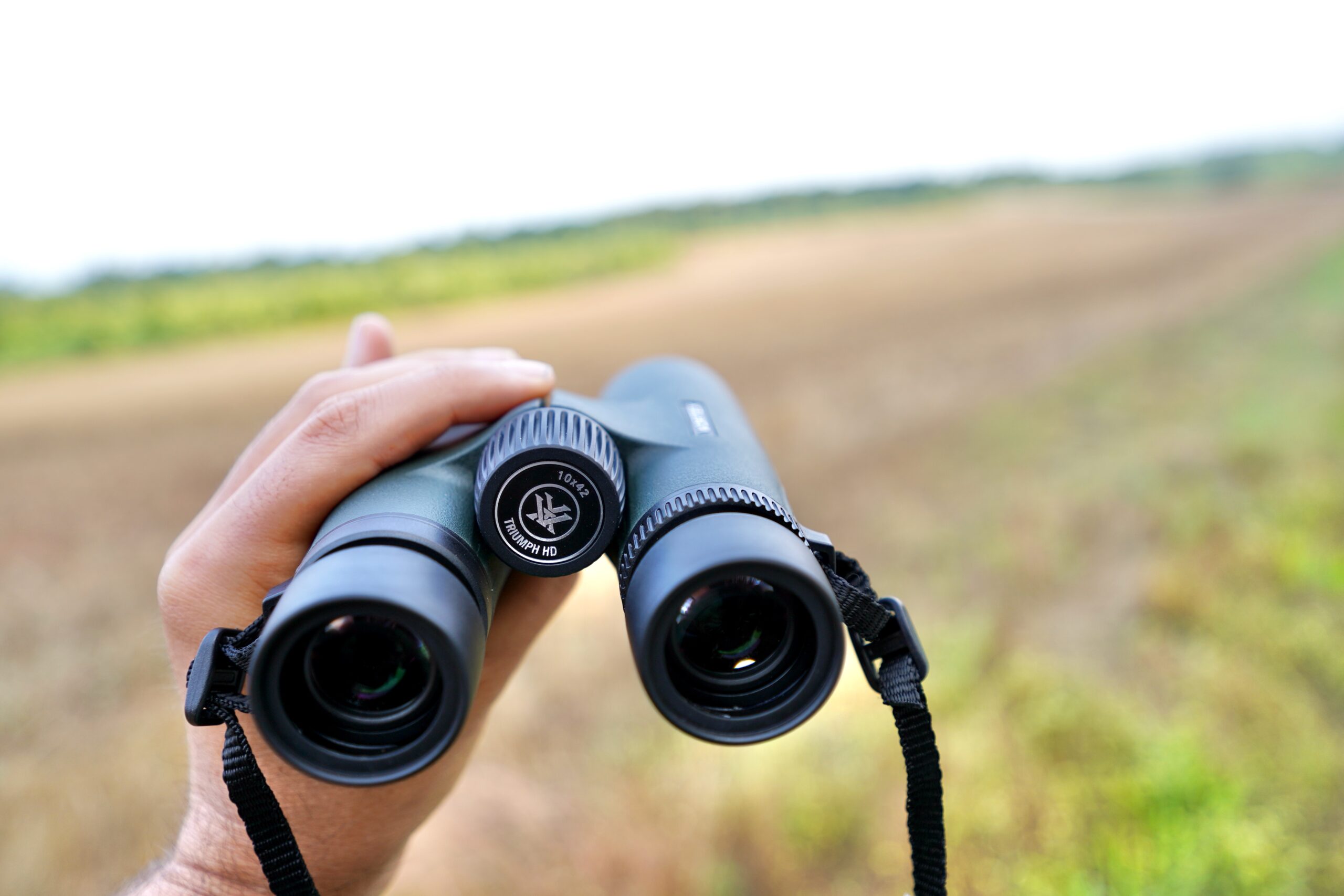
But we also recognized that you shouldn’t expect world-beating glass inside a $99 binocular, and that same realism pervaded our assessment of the Triumph’s mechanical performance. The diopter adjustment is stickier than we’d like, and the overall build feels flimsy. But the tapered eyecups move with positivity and the focus wheel is tight and responsive. The texturing, balance, and overall design is better than we’d expect for the price.
On the value side of the ledger, the GlassPak case and integrated harness confirms the best value designation we gave the Triumph HD. This would make a very good first optic for a hunter, birder, or shooter, and if treated gently is a good choice to throw in a pickup or cabin. We’re not sure how much rough handling this bino can take, but Vortex’s excellent warranty and customer service is a cheering consolation.
Read Best Binoculars for the Money to see more high-value binoculars. Or read our full Vortex Triumph HD review to learn more.
Best Compact: Zeiss SFL 8×40
Score Card
- Optical Performance: Very Good
- Mechanical Performance: Excellent
- Design: Excellent
- Price/Value: Very Good
Key Features
- Double-hinge, open-barrel design
- Right-barrel diopter control
- Oversized focus wheel
- Extremely light weight
- Also available in 10×40, 8×30, and 10×30 models
- Weight: 22.6 ounces
- Price: $1,800
Pros
- SmartFocus wheel zooms from close focus to infinity in 1.4 turns
- DoubleLink Bridge enables good barrel grip
- Premium glass and coatings
- 4.9-foot close focus
- Light
Cons
- At $1,500, fairly pricey binocular
- Straps and case are pedestrian
The world of premium binoculars apparently has no upper limit. You’ll pay over $3,000 for Swarovski’s excellent NL Pure or for Leica’s stunning Noctovid. Zeiss, too, asks $3,000 for its marvelous Victory SF binocular. So to find a binocular that performs nearly on par with those flagship models for half the price is worth talking about.
Zeiss saves some money on its SFL model by importing it from Japan; most premium optics are made in Germany, Austria, or Portugal. And Zeiss found some additional savings in glass by using thinner lenses than it uses in its SF line. Those thinner lenses also allow the SFL to shave nearly a half pound from the SF in the same configuration.
But the image delivered by those halfling lenses is every bit as sharp and vibrant as those of Zeiss’s other premium binoculars. The SFL easily posted the top resolution score at last year’s optics test, and testers raved about the vibrant image with rich contrast and stunning colors. It lost points on disappointing low-light performance, which was partly due to its diminutive 8×40 configuration.
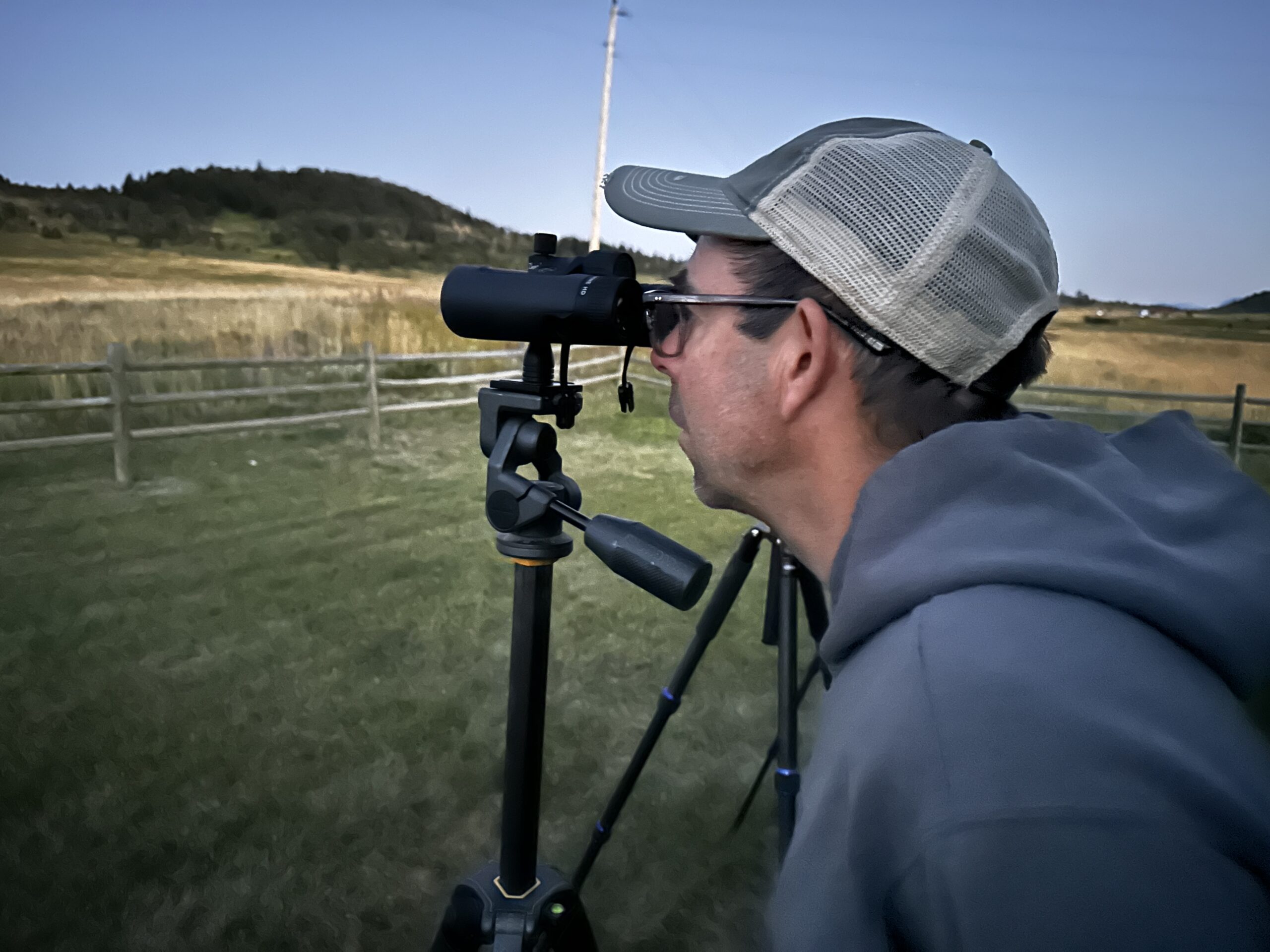
But the reason the SFL is here as one of the best hunting binoculars is its field-worthy operation. Its oversized focus wheel riffs from an extremely tight close focus of 4.9 feet out to infinity in just 1.4 rotations of the wheel. That’s a huge asset for brush hunters, who use their optics to pick apart various distances, and for Western hunters, who might pan from middle-distance cover out to far vistas in the same field of view. The focus wheel, it should be noted, moves as though it rides on ball-bearing tracks, so smooth and fluid.
The Zeiss’s name stands for SmartFocus Lightweight, and the 1.5-pound heft makes them the lightest premium binos on the market, and a wonderful companion for long hikes over difficult terrain. The balance and grip provided by the open-bridge design makes the SFL feel even lighter, and testers gave high praise for the binocular’s tapered eyecups that were extremely comfortable to use for extended periods.
That’s the real question to ask of a hunting binocular — how long do you want to spend behind it? The more and longer you use a binocular, the more game you’ll spot and the more successful you’ll be. Few other pieces of hunting gear have that outsized effect on your outcome. If the 8×40 isn’t for you, look to the SFL in 10×40, 8×30, and 10×30.
Read Next: Best Binocular Harnesses
Best Pocket Size: Maven B.7 8×25
Score Card
- Optical Performance: Good
- Mechanical Performance: Very Good
- Design: Very Good
- Price/Value: Good
Key Features
- Double-hinge, closed-bridge design
- Right-barrel diopter control
- Extra-low-dispersion glass
- Extremely compact design
- Also available in 10×24
- Weight: 12.4 ounces
Pros
- Highly textured focus and diopter controls
- Excellent treestand or turkey-vest optic
- Distinctive orange accents
Cons
- Too small for open-country glassing
- Controls hard to manipulate with gloves
With this petite binocular, introduced earlier this year, Maven is well on its way to filling out its product line. The B.7 is a compact version of the direct-to-consumer company’s excellent B.3 line.
It should be said at the outset that this is a fairly specialized optic. It’s configured for portability and use in tight quarters and in close ranges. Think whitetail hunting out of a treestand. A travel optic when weight and space is at a premium. Turkey hunting just about anywhere. I use sub-compact binoculars when upland hunting, tucked in a pocket of my upland-bird vest, in order to positively identify distant birds, to find my dog, or confirm a distant point.
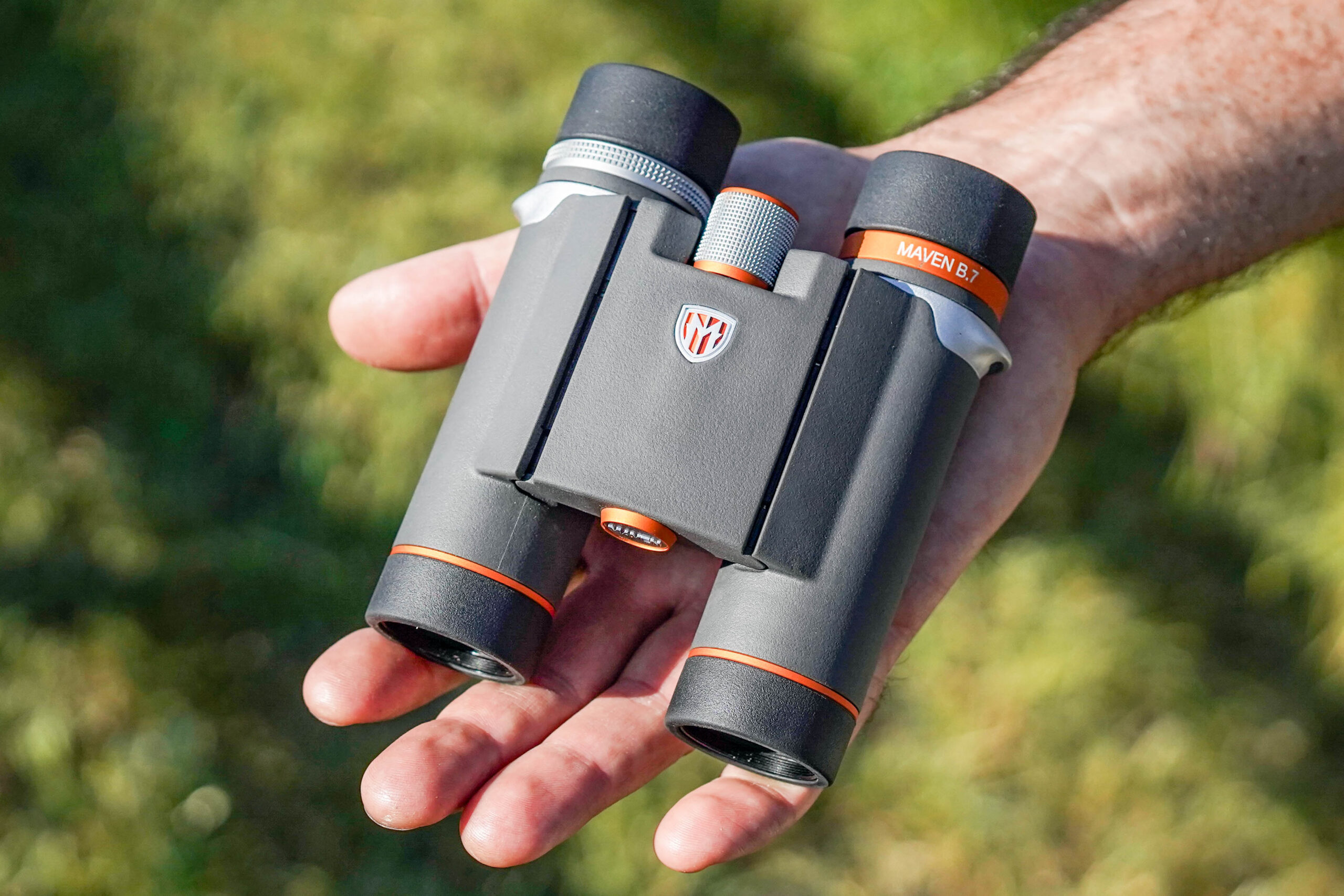
The Maven is one of the best-rendered versions of this class of diminutive binocular. The double-hinge design allows the barrels to nest under the bridge, and can fit inside a roomie shirt pocket. The glass is surprisingly good for this mini optic. Maven uses extra-low-dispersion glass that reduces glare and boosts colors and contrast of images, and helped the B.7 post one of the best resolution scores of our 2023 binocular class. But the ED glass is also responsible for the fairly steep price; the 8-power B.7 retails for $600; the 10-power version sells for $625.
Outdoor Life’s optics test team gave the binocular good price/value scores, and they praised the solid build and responsive controls. But several testers noted the limitations of the platform.
“This would be a good spot-and-stalk bino for those times when I don’t want to carry a pack or even a binocular harness,” said tester Ky Idler. Tester Dale Manning further noted that the B.7 would “make a great optic for sporting events, turkey hunting, deep-woods treestand hunting, but for me it’s too small to be a go-to field bino.”
Fair enough, but for those hunters looking for a combination of outsized optical performance in a very trim package, this binocular fits just about anywhere.
Read Next: Swarovski AX Visio Review: The Most Advanced, and Controversial, Birding Binocular
Best for Bowhunting: Vortex Razor UHD 8×32
Score Card
- Optical Performance: Excellent
- Mechanical Performance: Very Good
- Design: Very Good
- Price/Value: Very Good
Key Features
- Open-hinge open-barrel design
- Right-barrel locking diopter control
- Tripod-mountable
- 5.9-foot close focus
- Weight: 21.9 ounces
- Field of view: 472 feet at 1,000 yards
- Price: $1,450
Pros
- Durable magnesium chassis
- Premium glass
- Easy to use with a single hand
- Oversized focus wheel
- Ships with premium GlassPack Pro harness with rangefinder pouch
Cons
- At nearly $1,500 street price, expensive for an 8×32
- Thumb indents could be larger to accommodate large hands
Vortex’s new flagship binocular has it all: excellent glass, nice handling, a durable build, and wonderful field of view. The compact 8×32 in our test produces a big image out of proportion to its size, and testers noted it’s a perfect bowhunting optic, since it can be capably handled with a single hand and offers excellent mid-range performance. Enhancing its handling, whether you use one hand or two, the Razor UHD features thumb indentations in the chassis that are placed at the balance point of the binocular. That added touch allows for good gripping, though one ham-handed tester wanted these depressions to be a bit larger to fit his silver-dollar-sized thumbs.
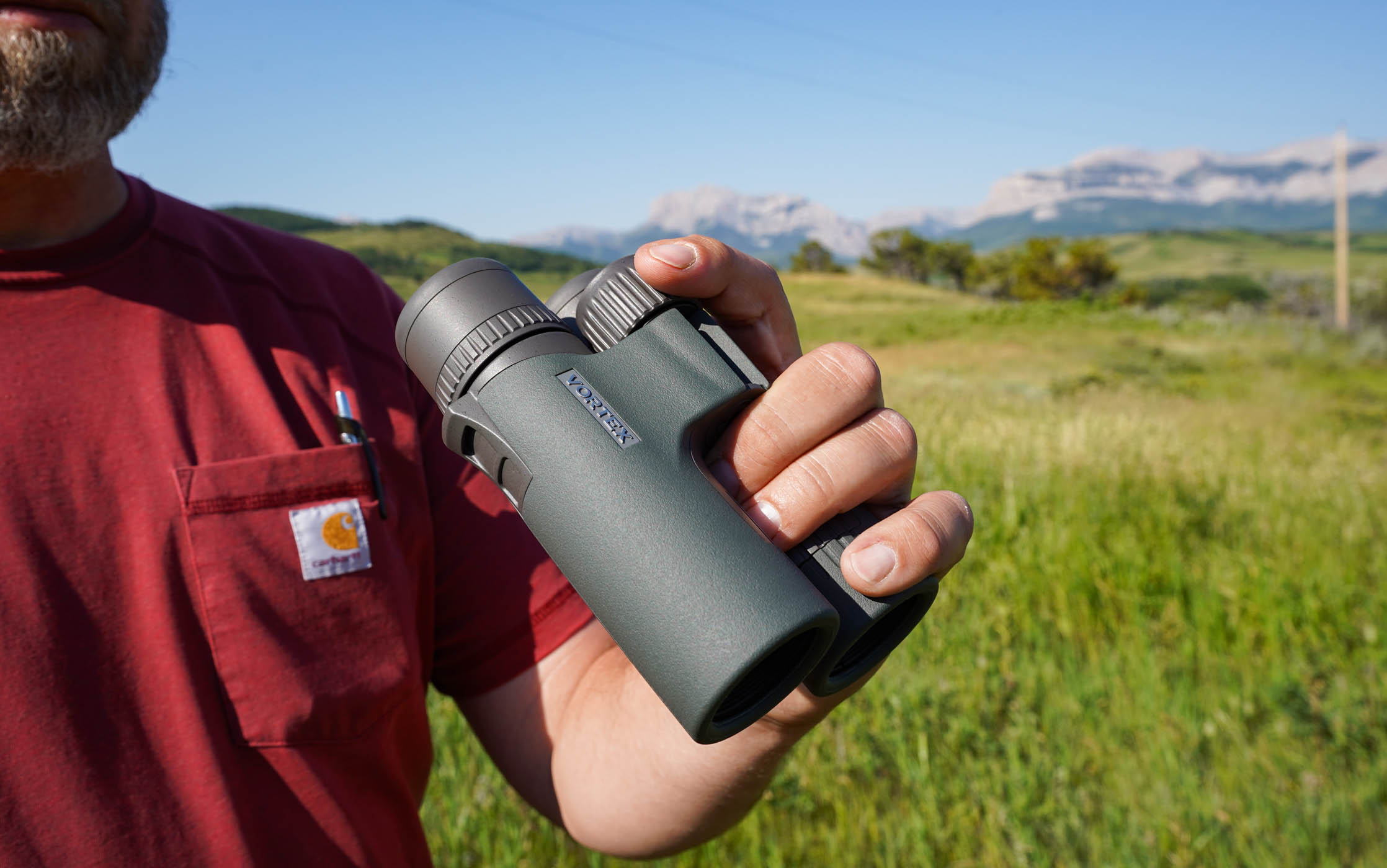
Scott Einsmann
The 8×32 joins a compact 10×32, both introduced this year, to fill out Vortex’s excellent Razor UHD line, which includes 10×42, 10×50, 12×50, and 18×56 models. The literalists of our test noted that the term UHD, which stands for Ultra High-Definition glass, doesn’t have a defined meaning. It’s a marketing term to refer to a higher grade of glass and coatings than those used in Vortex’s HD (pedestrian High-Definition) optics.
Regardless of semantics, its exceptional glass and coatings allowed the 32mm Vortex to hang with big 42mm and even a 52mm binocular in our low-light test. Other accolades for the Razor UHD include a locking diopter, fast-focus wheel, and thin eyecups that fit most brows. Perhaps recognizing that $1,500 is a lot to spend on a binocular, Vortex adds its very good GlassPak Pro harness and rangefinder pouch to the deal. Those accessories retail for around $150.
We did note a surprising aberration. Testers recorded noticeable flaring when they peered toward the sun, an optical anomaly that may be caused by dust on an interior lens. We didn’t expect to see that in an optic at this price point.
But most users are unlikely to notice that demerit, one of the very few in an otherwise capable, fine-handling, and extremely bright binocular. Given Vortex’s fully transferable lifetime warranty and exceptional customer service, any deficiencies that users note are bound to be covered by the company.
Top Binocular Innovation (Form-Fit Eyecups): Leupold BX-4 Pro Guide HD 10×42 Gen 2
Score Card
- Optical Performance: Good
- Mechanical Performance: Good
- Design: Very Good
- Price/Value: Good
Key Features
- Double-hinge open-barrel design
- Locking center-hinge diopter control
- Interchangeable “Form-Fit” eyecups
- Tripod-mountable
- 9.3-foot close focus
- Weight: 25 ounces
- Field of View: 314 feet at 1,000 yards
- Price: $600
Pros
- Aluminum chassis
- “Slim-hinge” design enhances one-hand operation
- Field-proven glass and coatings
- Ability to change eyecups in the field
- Ships with Go Afield bino harness ($50 value)
Cons
- Underwhelming glass
- Spongy focus
- Non-textured armor is slick
With configurations in just about every practical size and magnification, you might consider Leupold’s new BX-4 Pro Guide HD the binocular equivalent of its new Mark 4HD line of riflescopes: mid-priced do-everything optics.
Leupold introduced BX-4 Pro Guide HDs earlier this year in 8×42, 10×42, 10×50, and 12×50 configurations. We considered the 10×42 in our mid-sized bino test, where it fit nicely between premium optics costing well over $1,000 and entry-level optics priced around $300.
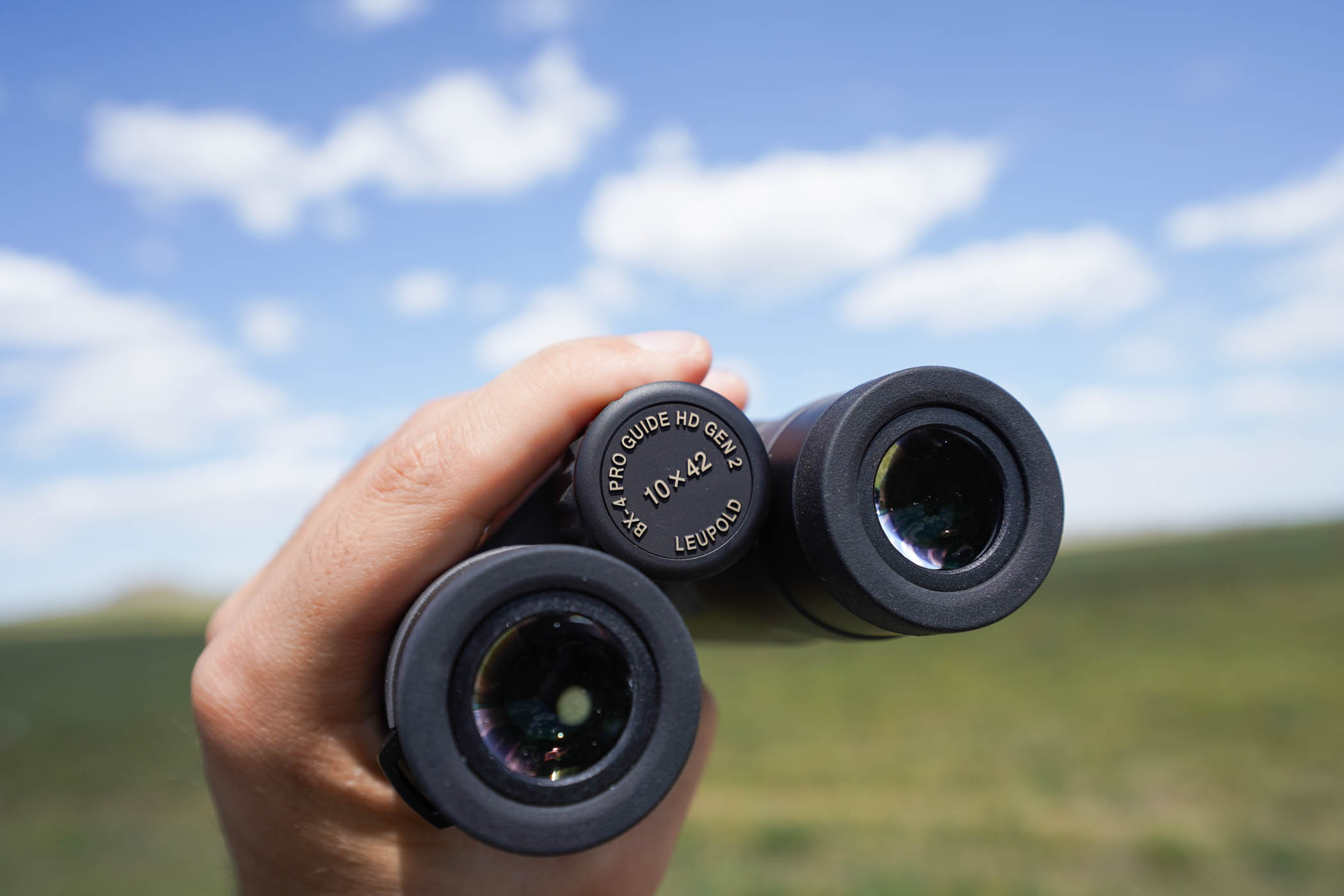
Scott Einsmann
“This is by far the best sub-$600 bino in the field,” wrote tester Dale Manning. Other testers praised the model’s open-barrel handling, locking center-hinge diopter, and innovative interchangeable eyecups. That last attribute — Leupold ships three different pairs of “Form-Fit” eyecups with its BX-4 Pro Guide HD, low- and medium-profile sets and a winged version designed to block out peripheral light — is an important point of distinction for the new line. It also answers the question: How can brands possibly improve the basic binocular? Well, Leupold has found a way.
We wish the image produced by the BX-4 Pro Guide HD was on par with its mechanics, handling, and eyecup innovations. Every tester recorded distracting blue color fringing, and most noted edge distortion. The field of view (stated at 314 feet at 1,000 yards) is noticeably narrower than most 10x42s and the apparent field of view is even more stingy. On the handling side, some testers noted that the tripod mount, located on the forward-most hinge, creates imbalance. We’d like to see that tripod mount on the interior hinge to better balance the unit.
That’s an admittedly minor quibble, considering that few users will mount a 10×42 binocular to a tripod. As a knock-about binocular that can capably handle just about any viewing conditions, the new Leupold line is more than adequate. The addition of easily interchangeable eyecups, which accommodate not only most facial features but also changing field conditions, is a true innovation that we expect to see replicated by other binocular brands.
Best Entry-Level: Hawke Frontier ED X 8×42
Score Card
- Optical Performance: Very Good
- Mechanical Performance: Good
- Design: Very Good
- Price/Value: Excellent
Key Features
- Closed-bridge design
- Right-barrel diopter control
- Tripod-mountable
- 6.6-foot close focus
- Weight: 25.6 ounces
- Field of View: 426 feet at 1,000 yards
- Price: $450
Pros
- Durable magnesium-alloy chassis
- Extra-low-dispersion (ED) glass
- Nicely textured controls
- Thin-profile tapered eyecups
- At less than $500, fairly priced
Cons
- Low-geared focus wheel
- Noticeable flaring
While it’s not widely known to American hunters, this British optics brand has sizeable market share internationally, especially among birders. The Frontier ED X, built around very good extra-low-dispersion glass and responsive controls, is a good example of the brand’s mid-priced, value-packed optics.
For an 8-power competing in a field of 10-power binoculars, the Frontier ED X held its own, scoring near the bottom of the low-light test but posting an exceptional resolution score. Testers like the trim eyecups and the nicely textured armor, though tester Ky Idler noted that the rubber armor on our sample was a little loose where it joins the objective lens rim, a demerit that might introduce dust and grit into the chassis.
Image scores were in the middle of the field. Testers generally liked the brightness, edge sharpness, and overall tone of the image, but most noted flaring and other optical aberrations, probably as the result of poorly finished interior blacking. The focus wheel also requires nearly three revolutions to zoom from close focus to infinity. One of the quiet advancements in binocular technology is focus wheels that cover the entire focal length in two or fewer revolutions, and we’d like to see the Hawke apply this to its offerings.
Like others in the Frontier ED X line — Hawke has versions in both grey and green armor in 8×32, 10×32, and 10×42 in addition to the 8×42 of our test — the binocular ships with a premium zippered vinyl semi-hard case and carry strap, a feature that added to its high price/value score.
Best for $400: GPO Passion SD 10×42
Score Card
- Optical Performance: Good
- Mechanical Performance: Good
- Design: Fair
- Price/Value: Good
Key Features
- Central-bridge design
- Right-barrel diopter control
- Tripod-mountable
- Weight: 24.6 ounces
- Field of view: 314 feet at 1,000 yards
- Price: $450
Pros
- Durable magnesium chassis
- Classy black-and-silver colorway
- Oversized focus wheel
Cons
- Two-position eyecups
- Spongy focus
- Rubber armor loose on chassis
With a real-world street price of about $400, there’s a good deal of value in this new line of binoculars from German Precision Optics, better known as GPO. In addition to the 10×42 in our test, the company is bringing to market 8×26, 10×26, 8×34, 10×34, and 8×42 models. Each wears the “SD” designation.
What does “SD” mean, exactly? “Substantial Definition,” according to GPO’s marketing materials.
That’s a meaningless optics term, even more bewildering than “high-definition” or “ultra definition” or the new favorite, “ultra high-definition.” As an optics tester, I’m constantly trying (in vain) to find out what differentiates HD, UHD, and now SD glass from its competitors. The GPO version seems to be a variety of high-transmission glass, which is a slightly higher grade of optical glass than that with no designation, but damned if I can tell you how much better it is. That’s why in our test we rely on what we see through the glass, rather than what marketers tell us we should see.
The new Passion SD glass actually isn’t that bad. Every tester noted some fairly distracting flaring, but it’s hard to say if that’s because of sub-premium glass or the noticeable dust on interior lenses. Internal lenses are nicely coated, and interior blacking is excellent. We also appreciate the high-quality zippered case and strap that ships with the Passion SD.
GPO is bringing the Passion SD to a very competitive place in the market. But it stands out for its magnesium chassis — many $400 binoculars are built on polycarbonate bodies — and that high-transmission glass. The in-hand feel is both substantial and tight, though testers wished the focus wheel wasn’t so spongy. We have no reason to doubt its durability and overall versatility.
Best Budget: Bushnell R5 8×42
Score Card
- Optical Performance: Fair
- Mechanical Performance: Fair
- Design: Good
- Price/Value: Very Good
Key Features
- Mid-barrel bridge design
- Right-barrel diopter control
- Tripod-mountable
- 7-foot close focus
- Weight: 24.9 ounces
- Field of View: 393 feet at 1,000 yards
- Price: $210
Pros
- At just over $200, nicely priced
- Nicely armored
- Double-textured controls
- Two-tone armor boosts shelf appeal
- Ships with useful Vault Lite chest harness
Cons
- Thumb detents too shallow
- Eyecups are hard and square
Pity our reviewers. They get the opportunity to field-test the sharpest, brightest, and most expensive field optics on the market, which can blind them to the requirements of mere mortals: the need to choose the best optics for more modest prices. That’s where our Great Buy award can steer buying decisions to those products that offer a ton of value for the price.
The brand-new R5 line from Bushnell, winner of our great buy award, is one of those smoking deals that won’t turn the heads of readers who are Zeiss, Leica, and Swarovski acolytes. But the Bushnell, which should retail for just over $200, offers decent performance and abundant versatility for a very accessible price.
“This would make a great kids binocular,” says tester Ky Idler, who liked the no-nonsense handling, decent glass, and fully transferrable lifetime warranty. Fellow tester Dale Manning similarly appreciated the value of the Bushnell, but also noted its hard eyecups, shallow thumb detents, and internal smudging.
There’s every chance you’ve never heard of the R5. That’s because it’s a brand-new product line from Bushnell, positioned between the new entry-level R3 line and the more aspirational R7 family of binoculars and riflescopes. Think of the R5 as the mid-tier Engage in Bushnell’s previous Prime/Engage/Forge lineup of optics.
The R5 is sourced in China, and has some forgettable attributes, including its ho-hum glass and spongy controls. But one of the advantages of an established optics company like Bushnell is that even its price-point products benefit from its excellent coatings. The R5’s exterior lenses are coated with Bushnell’s EXO Barrier that cuts glare and boosts color fidelity. Adding to its value, the R5 ships with Bushnell’s very good Vault Lite chest harness.
This is more than a kids’ binocular. It’s a great value on an optic that should serve several seasons of honest use while its owner saves up to buy more aspirational optics.
Best Value Truck Binocular: Riton 5 Primal
Score Card
- Optical Performance: Good
- Mechanical Performance: Fair
- Design: Fair
- Price/Value: Fair
Key Features
- Closed-hinge design
- Right-barrel diopter control
- Tripod-mountable
- 4 ½-foot close focus
- Weight: 26 ounces
- Field of View: 380 feet at 1,000 yards
- Price: $500
Pros
- Aluminum-alloy chassis
- Extra-low dispersion glass
- Long eye relief for eyeglass wearers
- Three-position eyecups
Cons
- Arbitrary focusing
- Spongy focus control
- At about $650, pricey
This is a very good $225 binocular that seems to be mispriced at about triple that amount. That may be a function of its better-than-expected extra-low dispersion glass, or an optic that’s price-positioned for deep discounting after it hits the market, but the controls that surround the internal works are at best forgettable and at worst curse-causing.
“I had a hard time keeping a tack-sharp focus,” reports tester Dale Manning. “I can’t put my finger on it, but this binocular gave me a headache.”
Other testers similarly reported spongy or imprecise controls. That’s too bad, since the Riton’s very good glass ruled our low-light test, holding its own with European-sourced optics that cost four to five times the price of the 5 Primal.
But the binocular’s sharp extra-low dispersion glass is degraded by obtuse controls. Not only is the focus spongy, but the diopter is soft and mushy, and the otherwise excellent armor is loose-fitting around the barrels. If priced at the same point as the Bushnell R5, this would be a contender for our great buy award, but at over $600, we question the value of the 5 Primal.
Best Rangefinding Binocular: Leupold BX-4 Range 10×42
Score Card
- Optical Performance: Good
- Mechanical Performance: Very Good
- Design: Good
- Price/Value: Very Good
Key Features
- Ambidextrous ranging button
- 2,600-yard ranging capability
- Uses Leupold’s wind and ranging engines
- 12-yard minimum range
- Tripod adaptable
- Loaded with 25 ballistic groups
- Weight: 39 ounces
Pros
- Fast laser processor
- Employs Leupold’s True Ballistic Range/Wind tech
Cons
- No Bluetooth connectivity to an app
- Square, brick-like hand feel
Because this is a review of binoculars that appeal to a wide range of users, and not just hunters, the idea of incorporating a laser rangefinder inside a traditional binocular may cause some confusion. But if you open your mind, the application of rangefinding has no limits. Say you’re a birdwatcher who wants to know just how close you got to that peregrine falcon. The Leupold gives you the answer. Or maybe you’re a biologist who needs to know the specific distance between camera trap and bait site. The Leupold will easily calculate the answer.
What makes the BX-4 Range worth including in this review of essential binoculars is that it brings excellent optics, solid durability, and smart functionality to the category. The LRF bino is an impressive confluence of the brand’s far-ranging talents with both field optics and rangefinding electronics. The BX-4 Range binocular borrows from Leupold’s software that combines its long line of laser rangefinding monoculars with very good binocular optics.
The BX-4 Range is not without faults. It’s approximately the size and weight of a brick, with similar angular contours. Its eyecups are square and uncomfortable. And the Leupold’s ranging talents are relatively unimpressive. The BX-4 bucks the trend in precision shooting circles by omitting Bluetooth connectivity to a mobile ballistic app, and it doesn’t have sophisticated (and expensive) on-board environmental sensors that help direct bullets. Instead, it has a simple and useful laser rangefinder that ranges from 12 to 2,600 yards.
The Leupold has very good optics, though because rangefinders use an additional lens element for the ranging beam-splitter, and because coatings are tuned to make the red OLED display pop, the optics aren’t quite as clear and crisp as a binocular without the electronics. And at about $1,600, the BX-4 Range is a relative bargain, providing users with a capable rangefinder and a very good binocular. When you add Leupold’s excellent warranty and customer service, the BX-4 makes the case as a serious and useful field companion.
Read Next: Best Rangefinder Binoculars
Best Ballistic Rangefinding Binocular: Leica Geovid Pro 10×42
Score Card
- Optical Performance: Very Good
- Mechanical Performance: Excellent
- Design: Excellent
- Price/Value: Good
Key Features
- Premium glass
- Laser ranging to 3,000 yards
- Pre-installed Applied Ballistic Ultralight software
- Double-hinge, open-bridge design
- On-board environmental sensors
- Rugged magnesium chassis
- Also available in 8×32, 10×32, 8×42, and 8×56 versions
- Weight: 34.2 ounces
Pros
- GPS-enabled tracking aid
- Wide field of view
- Custom ballistic profiles available through Bluetooth
- Connects to mobile app and Kestrel devices
Cons
- High and long learning curve
- At about $3,300, very expensive
- At over 2 pounds, it’s a unit
If Leupold’s new BX-4 Range is the perfect rangefinding binocular for hunters, and Sig’s phenomenal KILO10K is a must-have optic for long-range shooters, then the Leica Geovid Pro 42 is a unit that brings its talents to both walk-about hunters and hard-core precision shooters. This European high-performance optic has so much under the hood that it can take an entire hunting and competition season to unlock its capabilities.
Want a very precise laser rangefinder that offers aiming prescriptions for your specific custom rifle load? The Geovid Pro 42 will deliver it by connecting to Leica’s excellent Leica Ballistics App 2.0. Or maybe you want best-in-class glass to make a low-light shot? Leica’s very good glass and optical design delivers. Or maybe you want to know where that animal was when you took your shot? The GPS-enabled mapping service pairs with your mobile phone to show you precisely where to begin tracking.
The unit also pairs with Kestrel devices to get real-time wind direction and speed updates, and the on-board software calculates windage holds based on that information. The software also calculates angle of the shot, air pressure, temperature, and altitude, essentially giving you super powers as a lethal shot, whether at game animals or at steel plates.
The 42mm version of the Geovid Pro is new for this year; the inaugural version of the platform debuted in a 10×32 configuration last year. The 10×42 is relatively boxy and hefty, tipping the scales at a little over 2 pounds. For most hunting situations where I might need all the laser rangefinding capabilities the platform delivers, extreme backcountry hunts in rigorous terrain, I’d probably opt for the trimmer 10×32. But with better field of view and low-light performance plus all the precision-shooting capabilities of the 32mm Geovid, the 42mm unit represents a gargantuan achievement in the integration of electronics and optics.
Best Mid-Priced Binocular: Tract Toric UHD 10×42
Score Card
- Optical Performance: Excellent
- Mechanical Performance: Very Good
- Design: Good
- Price/Value: Good
Key Features
- Built around premium Schott high-transmission glass
- Premium coatings
- Magnesium-alloy chassis
- Grippy armor
Pros
- Direct-to-consumer brand saves on overhead and distribution
- Fully transferable lifetime warranty
- Wide field of view
- 8.2-foot close focus
- Fairly priced at about $700
- Locking diopter
Cons
- At about $700, a significant purchase
- Fairly generic looking binocular
The fact that there’s nothing jaw-dropping to say about this quietly serviceable binocular actually says volumes. It’s not trying to be the next super-optic, or to connect to your smartphone or your smarter refrigerator. Instead, this is a capable, dependable binocular that’s built around a very good class of glass and has some very appealing controls, from the precise focus knob to the best eyecups in the class.
As a direct-to-consumer brand, Tract is able to save on distribution and retail overhead costs, and pass on the savings to consumers. If that model is correct, then you get more quality and performance for less cost than you get from leading brands that sell products through traditional retail channels.
The Toric UHD is not a cheap binocular. At $694 for the 10×42 version, it’s a significant investment for most hunters and outdoors folks. But the unit is dependable and solid. The image it delivers is sharp and bright. And it’s a joy to hold and use, owing to its excellent controls. The Toric UHD is available in 8×42, 10×50, 12.5×50, and 15×56 versions, all built around the same premium glass and covered by a very good warranty.
The Best Large Frame Binoculars
Big, tripod-mounted binoculars are no longer relegated to the rugged Coues deer country of the Southwest or desert sheep hunts. They’re useful for any mid-distance observation where both-eyes-open glassing reduces fatigue and expands fields of view. Think a long day spotting hits at a precision rifle course or hours-long glassing across canyons at elk or spring bear.
Happily, there are more of these large-frame binoculars coming to the market this year than in most, with nine brands producing models in 12-, 14-, 15-, and even 18-power. Most are new for the year, though we also considered a couple—Vortex’s Razor UHD 18×56 and Hawke’s Vantage 12×50—that have been available for a few years.
These magnifications are powerful enough to resolve detail beyond a half-mile, but their image doesn’t swirl and distort with mirage like high-power spotting scopes. They’re also much more portable than spotters. At the lower end of their magnification, these binoculars can be hand-held, but they’re at their best when mounted to a tripod, and we judged the merits of this crowd of nine binoculars—at a wide range of prices, magnifications, and performances—as tripod-mounted optics.
Best Overall: Swarovski NL Pure 14×52
- Optical Performance: Excellent
- Mechanical Performance: Excellent
- Design: Excellent
- Price/Value: Very Good
Key Features
- Wasp-waist, open-barrel design
- Center-wheel diopter control
- Oversized focus wheel
- Very wide (306 feet at 1,094 yards) field of view
Pros
- Premium field-flattener lenses
- At 36 ounces, very light for the category
- Premium glass and coatings
- 12.5-foot close focus
- 91 percent overall light transmission
Cons
- At $3,449, a wildly pricey binocular
- Tripod mount sold separately
This is one of the very few instances in which the highest-scoring optic in a category isn’t the winner of our Editor’s Choice award. That’s because, while the NL Pure is a nearly perfect large-frame binocular, with world-beating image and brightness, testers reckoned that, at $3,500, it had better be. Furthermore, because Swarovski fails to include its $200 tripod mount with the NL Pure, we weren’t able to assess the binocular in the manner that we’d expect, by strapping it to a tripod to minimize its shaking and benefit from its exceptional glass and coatings.
Those sound like petty demerits, but had Swarovski made its tripod receiver with a standard ¼-20 thread, we could have used any number of mounts. But, like its strap fasteners, the tripod mount is of a proprietary design and requires specialized hardware, thereby limiting the optic’s utility.

Scott Einsmann
With that huff out of the way, this is one of the world’s great optics. The glass is vivid and bright, and the NL Pure’s field-flatter ocular lenses ensure edge sharpness. The field of view, just over 300 feet at 1,000 yards, is exceptional for a 14-power binocular. And the “wasp-waist” design that tapers into the hands allows for wonderful handling. The 14-power is a bit too powerful to hand-hold without shaking, but the optic handles nicely and its 36 ounces seems much lighter because of its lively balance.
The Swaro posted the top resolution score and competed quite well in our low-light test against models with larger objective lenses and magnification. We gave it high marks for image quality and comfort. And many testers, despite grumbling about its stratospheric price, gave it high price/value scores. While they took off points for a non-locking center-barrel diopter adjustment, testers also gave high marks for design and durability. The one category it tanked was mountability, thanks to that cuckoo-clock tripod mount.
As we noted in the 10×52 review, a work-around is to buy the $60 NL Pure tripod stud from Outdoorsman and install it yourself. With this adapter, you can then use just about any aftermarket tripod mount.
The 14×52 configuration of the NL Pure is new this year, along with the 10×52 that won our regular binocular test (and took Editor’s Choice honors!). It’s a larger format of the NL Pure, which was introduced to the world three years ago in 32mm and 42mm configurations. There’s a use case to be made for each of these iterations, but unless you invest in the sold-separately tripod mount, the 14×52 may be a little large for casual observation. If you’re looking for the best combination of magnification and optical horsepower, and have an idle $3,049 laying around, the 12×42 NL Pure may be your best bet.
Your reward is a rich, luxurious image delivered through a work of optical art.
Best for Long-Range Shooting: Maven B.5 MOA/MIL 18×56
Score Card
- Optical Performance: Excellent
- Mechanical Performance: Excellent
- Design: Very Good
- Price/Value: Very Good
Key Features
- Center-hinge open-barrel design
- MOA- or MIL-based reticle in left eyepiece
- Right-eyepiece diopter control
- Left-eyepiece reticle leveler
- Tripod-mountable
- 9.8-foot close focus
- 45 ounces
- Field of view: 194 feet at 1,000 yards
Pros
- Durable magnesium chassis
- Premium ED fluorite glass
- Excellent shooting-range companion
- Tripod thread cover removes easily
- Nicely textured controls
Cons
- In non-shooting situations, reticle is distracting
- Relatively narrow use case
As a very capable companion to a competition shooter or for hunters who want to range distant targets without relying on electronics, this reticle-equipped binocular is your baby. The 18×56 Maven features excellent glass, silky controls, and a heft and balance that settles nicely on a tripod.
If you’re looking for a high-mag binocular for pure observation purposes, you’re better off saving a couple hundred bucks and buying Maven’s B.5 without the built-in reticle.
The 18-power B.5 MOA/MIL in our test, however, comes complete with a reticle (our test sample had the MIL-based reticle), and we found it to be a worthy substitute for spotting scopes with ranging reticles (see our test of this category elsewhere on the site). At 18-power, the Maven offers very comfortable both-eyes-open viewing with enough magnification to resolve targets out to 1,200 yards. The magnification also reduces mirage effect on hot, sunny days at the range, an aberration that has frustrated countless shooters who rely on high-power spotters to resolve targets and register hits.
The reticle, with 20 MILs of elevation references in .2-MIL increments and .1 MIL ranging segments (the MOA version has 80 MOA of drop in 1 MOA steps), performed beautifully as a reference for a shooter behind a MIL-based scope. We could communicate observed misses, call for adjustments, and get the shooter onto the target quickly and effectively. The B.5 has two reticle controls in the left-hand eyepiece. One focuses the reticle to users’ prescription; the other levels the reticle, a critical consideration since as the binocular’s interpupillary distance changes with each user, the reticle will be moved off plumb. The leveler ensures that the reticle can be trimmed to remain parallel with the observed horizon.
In general observation testing, we evaluated the B.5 both with the reticle focused to the users’ prescription and also fuzzed out, and determined that, for non-ranging purposes, the binocular is at its best when the reticle is sharply focused. That said, if you use the B.5 for general observation, the reticle is distracting. Compared to non-reticle-equipped binoculars, the Maven has a brassy, somewhat under-coated image, probably in order to make the reticle stand out against the background. Speaking of visibility, we did notice the fairly fine reticle got lost against dark or cluttered backgrounds; it’s most visible when viewing clean and bright targets.
From a handling standpoint, the B.5 is heavy but settles nicely on a stout tripod. Its controls are silky and precise. And, while the field of view is fairly stingy, it’s on par with other 18-power binoculars and is certainly wider than monocular spotting scopes. With a $1,700 price tag, this is a fairly pricey optic considering its narrow use. But if you’re a hardcore shooter looking for a reticle-equipped range companion with excellent controls and optics, Maven’s B.5 is one of the best choices on the market and a surprisingly effective alternative to a spotting scope.
Best for Hunting: Vortex Razor UHD 18×56
Score Card
- Optical Performance: Excellent
- Mechanical Performance: Excellent
- Design: Very Good
- Price/Value: Very Good
Key Features
- Closed-bridge, open-barrel design
- Right-barrel locking diopter control
- Tripod-mountable
- 10-foot close focus
- 42 ounces
- Field of view: 194 feet at 1,000 yards
Pros
- Durable magnesium chassis
- Tapered barrels easily accommodate tripod mount
- Premium glass
- Ships with premium Glass-Pak Pro harness
- Comfortable tapered eyecups
Cons
- Extremely shallow thumb indents
- Very forward-heavy
Vortex has had this exceptional large-frame binocular in its product line for a couple years, and it’s become a darling of the Western sit-all-day glassing crowd. It’s easy to see why. The 18-power magnification offers 20 percent more reach than typical 15-power binoculars, and the field of view is about 25 feet wider than a 20x eyepiece on a typical spotting scope. Plus, the pleasing image delivered by the Razor UHD invites users to immerse themselves in the experience, meaning that it’s a pleasure to spend hours behind this impressive optic. As we noted with other 18- and 15-power binoculars, mirage-caused blurring during mid-day glassing sessions isn’t nearly as pronounced as it is through full- and mid-sized spotting scopes, making this an excellent optic for use in hot, sunny early hunting seasons.
Furthering the field talents of the Vortex, the substantial barrels have a strategic bend in their middle, reminding us of a middle-aged man sucking in his gut for a photograph. The bend is there to accommodate a tripod mount while allowing full interpupillary travel, even for users with eyes placed close together. Many of Vortex’s competitors, without this thoughtful touch, don’t quite allow their tripod-mounted barrels to squeeze close for kids and users with smaller facial features.
We found the controls of the Razor UHD to be tight and precise, and we especially like the locking diopter and tapered three-position eyecups. We could find very little to critique about the Razor UHD, and felt that the real-world price of $1,999 is about right for the combination of excellent glass, durable construction, and tasty handling of the binocular, especially since it ships with Vortex’s top-of-the-line harness.
Best Image Stabilized: SIG Sauer ZULU6 16×42
Score Card
- Optical Performance: Very Good
- Mechanical Performance: Very Good
- Design: Good
- Price/Value: Very Good
Key Features
- Image-stabilized binocular
- Waterproof and fogproof
- 40-hour run time
- 25.2 ounces
- 16.4mm eye relief
Pros
- Improved optics with ED glass
- Powered by two AA batteries
- 10-minute auto shutoff
- Excellent vibration control enables tripod-free glassing
Cons
- Unimpressive close focus
- Independent eyepieces take lots of tuning
- Focus knob is awkwardly placed
It’s unfair to put this image-stabilized binocular in a field of analog optics that requires a tripod to stabilize. But the inclusion of the 16×50 Sig recognizes an important trend in the category. Many Western hunters are opting for high-magnification image-stabilized binos like the Sig to glass for elk, deer, sheep, and other big-country game, and we wanted to see how a new participant in the market compares against traditional 15×56 and 18×56 binoculars.

Scott Einsman
Very well, it turns out. The ZULU6, which will also be available in 14×50 and 18×50 configurations when they hit the market next month, surprised the team with a very sharp, bright image that doesn’t require a tripod. We strapped the Sig to a tripod in order to further assess its talents, and tested its performance with the image-stabilizing gyroscope on and off, and found image brightness and sharpness is best with the OIS (Optical Image Stabilization) on.
That’s because the Sig optimizes stabilization using an on-board digital accelerometer to detect movement and vibration and then calibrates the amount of shake-canceling offsets to add to the binocular. The result is a sharp image with decent optical resolution even when held in a shaky hand.

Scott Einsman
If only the ZULU6 was more fun to hold. Testers took to calling this “The Brick” because of its severely square lines and clunky handling. There’s no defined balance point, and the smallish focus knob is awkwardly placed near the front of the optic. The eyepieces move independently, and require users to fine-tune their interpupillary distance and eyecups to their own features. Sharing the unit requires lots of fussing and cussing.
Interestingly, we noted that image-cancelling doesn’t have much effect on light transmission. In our low-light test, where we tested performance with the electronic stabilizer on and off, images may be slightly brighter, but they’re also fuzzier because of vibration. With the gyroscope turned on, images appear brighter because they’re sharper. The ZULU6’s coatings and extra-low dispersion glass are noticeably brighter and more vibrant than previous image-stabilized binoculars from Sig we’ve tested.
The ZULU6 operates on a pair of commonly available AA batteries, and the company says they provide 40 hours of run time, a claim we didn’t verify. We felt the real-world street price of about $1,600 is about right for its talents, and while we worry about the durability of the plasticky binocular, Sig offers an excellent warranty. For a tripod-sized binocular that doesn’t require a tripod, this is a very useful and versatile optic and one we expect to see increasingly in the game fields of the West.
Best Rangefinding: Leica Geovid R 15×56 LRF
Score Card
- Optical Performance: Very Good
- Mechanical Performance: Good
- Design: Very Good
- Price/Value: Good
Key Features
- Integrated laser rangefinder
- Range: 11-2,000 yards
- Line-of-sight and angle-adjusted measurement
- 19.4-foot close focus
- 45.9 ounces
- Field of view: 225 feet at 1,000 yards
Pros
- Aluminum chassis
- Premium glass
- Precise and positive controls
- Comfortable tapered eyecups
Cons
- Not easily tripod-mountable
- No distance-adjusted ballistic information
This excellent long-range hunting optic combines three of Leica’s core strengths: laser-rangefinding, premium observation, and ergonomic design. We weren’t sure about that last attribute, because the Geovid R looks square and bricky, and Leica has set our expectations of svelte exterior styling so high with its graceful Geovid Pro that any straight lines throw us off.
But the Geovid R balances well and offers sure, precise controls. It behaves adequately when mounted to a tripod, but because it can’t use a traditional hinge-threaded tripod mount—it has a laser emitter in the very place most binoculars place their ¼-20 thread—users have to find other ways to anchor it to a tripod. That’s an important consideration, because this rangefinding behemoth is so big and its 15-power magnification so powerful that you’ll want to mount it in order to get its best performance.
That performance is tailored to hunting the wide-open spaces of the American West and in the high-angle game fields of mountains from Turkmenistan to the Yukon. The Geovid R is at home in situations where users sit behind their glass for hours, picking apart an alpine cirque or a scorching-hot desert canyon, until they get a sudden chance to make the shot of a lifetime. You don’t want to be searching for your rangefinder at this moment, or to take your eye off your trophy. The Leica allows users to glass and range in the same field of view.
What the Geovid R doesn’t offer is an extensive on-board ballistics package or connectivity to a mobile app. You need to step up to the Geovid Pro for those features, but the lack of complicated whiz-bang electronics is actually very refreshing, and makes the Geovid R the go-to LRF binocular for hunters who want to know two things precisely: what’s the target, and how far is it?
With both angle-adjusted and line-of-sight ranging, the Leica provides fast, simple aiming information. And its image is excellent, especially when tripod-mounted, allowing hunters to use this device rather than mid-power spotting scopes for their observation. The image delivered by the Geovid R is vivid, crisp, and bright.
Astute readers may wonder why the Geovid R is entered in our large-frame binocular category instead of our laser-rangefinding binocular category. Actually, it’s one of the few optics that makes an appearance in both. It’s not a wonderful fit for either—its beam-splitter that enables the red LED display to appear in the right barrel reduces its light transmission and overall optical performance. And its simple LRF feedback doesn’t have all the app-connected capability of the best rangefinding binoculars—but it’s one of the most capable optics for those ambitious hunters who know that less is more when it comes to finding and hunting exceptional animals.
Best Binocular Innovation: Leupold BX-4 Pro Guide HD Gen2 12×50
Score Card
- Optical Performance: Good
- Mechanical Performance: Good
- Design: Very Good
- Price/Value: Good
Key Features
- Double-bridge, open-barrel design
- Center-dial diopter control
- Tripod-mountable
- 10-foot close focus
- 29.3 ounces
- Field of view: 257 feet at 1,000 yards
Pros
- One-hand handling
- Heavily textured focus wheel
- Choice of three different eyecups
- Three-position eyecups
- Ships with premium Pro Guide bino harness
Cons
- Underwhelming glass
- Rear-heavy balance on tripod
- No indexing on diopter control
One of a quartet of new BX-4 Pro Guide HD Gen2 (that’s a mouthful!) models released by Leupold this year, this is the highest-magnification member of the family, and while a 12×50 occupies the lower end of the large-frame field, the Leupold has some appealing attributes for users who plan to mount the optic on a tripod.
Happily, for those users who want to pack this binocular and hand-hold it, it also offers excellent ergonomics, size, and weight for walk-about glassers.
The most noteworthy detail about the new line of Leupold binoculars is the “Form-Fit” eyecups. Each model ships with three pairs of eyecups designed to be swapped easily in the field. There’s a tapered set, which fits most of our testers’ faces nicely. Then there’s a more squared-off version that comfortably fits eyeglass-wearers. Lastly, there’s a batwing version with a flange designed to block peripheral light from the outside of a user’s eye. The various eyecups are easy to change in the field, but fit tightly with no indication that they’ll fly off mid-hunt. It’s a simple innovation, but one of the smarter and more noteworthy advances in the state of binocular design over the last several years, and one we expect to see other brands follow.
Internally, the Leupold’s glass didn’t quite live up to our expectations. We noted a distracting blue color fringing around the periphery of the image, and the BX-4 finished near the bottom of our low-light test. Design-wise, we wanted indexing on the center-dial diopter control and found the tripod mount on the forward-most hinge to create a significant rear-heavy imbalance when mounted on a tripod. We’d like to see Leupold move this tripod socket to the rearward hinge, where it would better balance the binocular.
Given the performance shortcomings, we felt the BX-4 Pro Guide HD Gen2 was overpriced by a couple hundred dollars, even with the included Pro Guide harness. But with a few design improvements and a slightly better grade of glass, the Leupold would win our nod as a great all-around hunting optic.
Best Entry-Level: Bushnell R5 12×50
Score Card
- Optical Performance: Very Good
- Mechanical Performance: Fair
- Design: Good
- Price/Value: Very Good
Key Features
- Closed-bridge design
- Right-barrel diopter control
- Tripod-mountable
- 6 ½-foot close focus
- 31 ounces
- Field of view: 273 feet at 1,000 yards
Pros
- Nicely textured controls
- Distinctive two-toned armor
- Tripod thread cover removes easily
- At about $250, priced accessibly
Cons
- Polycarbonate frame
- Spongy focus
This new entry from Bushnell shares the not-quite-a-fit problem of the Leupold and Hawke. At 12×50, it rides the divide between a walk-about binocular and one that performs its best when mounted to a tripod. That versatility is a strong suit for all three models, and it’s especially noticeable with the Bushnell, which balances nicely on a tripod but which is at its best as a truck binocular or a high-powered optic for a Western hunter.
The Bushnell’s optics won’t turn any heads. While it posted an excellent resolution score, it finished near the bottom of our low-light test. Testers noted significant edge distortion, especially when it was mounted to a tripod, which allows users to really focus on peripheral objects. Tester Nate Ward, an eyeglass wearer, noted that the R5 didn’t quite have enough eye relief for users with spectacles.
Still, the handling and performance of the Bushnell is in line with its appealing price. Expect this R5 line to do very well at big-box retailers, and to enable a sizeable number of hunters and wildlife watchers to afford a binocular that will serve them well in the field. Adding to its appeal is a lifetime warranty and the very good Vault Lite harness that ships with the R5.
Best Budget: Hawke Vantage 12×50
Score Card
- Optical Performance: Fair
- Mechanical Performance: Good
- Design: Good
- Price/Value: Very Good
Key Features
- Closed-bridge design
- Right-barrel diopter control
- Tripod-mountable
- 8.2-foot close focus
- 25.3 ounces
- Field of view: 263 feet at 1,000 yards
Pros
- Three-position eyecups
- At just over $200, accessible price
- Grippy armor
- Oversize focus wheel
Cons
- Glitchy glass
- Plasticky feel
For a Western hunter on a budget, there’s a lot to like about this price-point 12×50 from Hawke. While its glass is forgettable and its controls are spongy, the price-per-magnification of the Vantage makes it an appealing bargain.
But there’s also a lot to dislike about the Hawke, starting with its glass that led it to a last-place finish in our low-light test and one of the lower resolution scores in the field. Testers noted some uncoated internal lens surfaces, which probably created flaring, color fringing, and edge distortion. But when you consider that the Vantage was in the same field as submissions from Swarovski, Leica, Zeiss, and Leupold, it’s hard to compare this entry-level binocular with heirloom-quality optics.
We spent a good deal of time with the Hawke on a tripod, but unlike other large-frame binoculars in the 15×56 and larger class, we also took this off the support and used it as you would an 8×32 or 10×42 binocular, in hand or with found supports like fenceposts and backpacks. Freed of the tripod, the Vantage performed quite well, with a light, balanced feel and decent controls.
It’s a good choice for a hunter on a budget who wants a powerful binocular for the open fields of the West or as an adequate binocular for a patio or pickup console.
How to Choose a Binocular
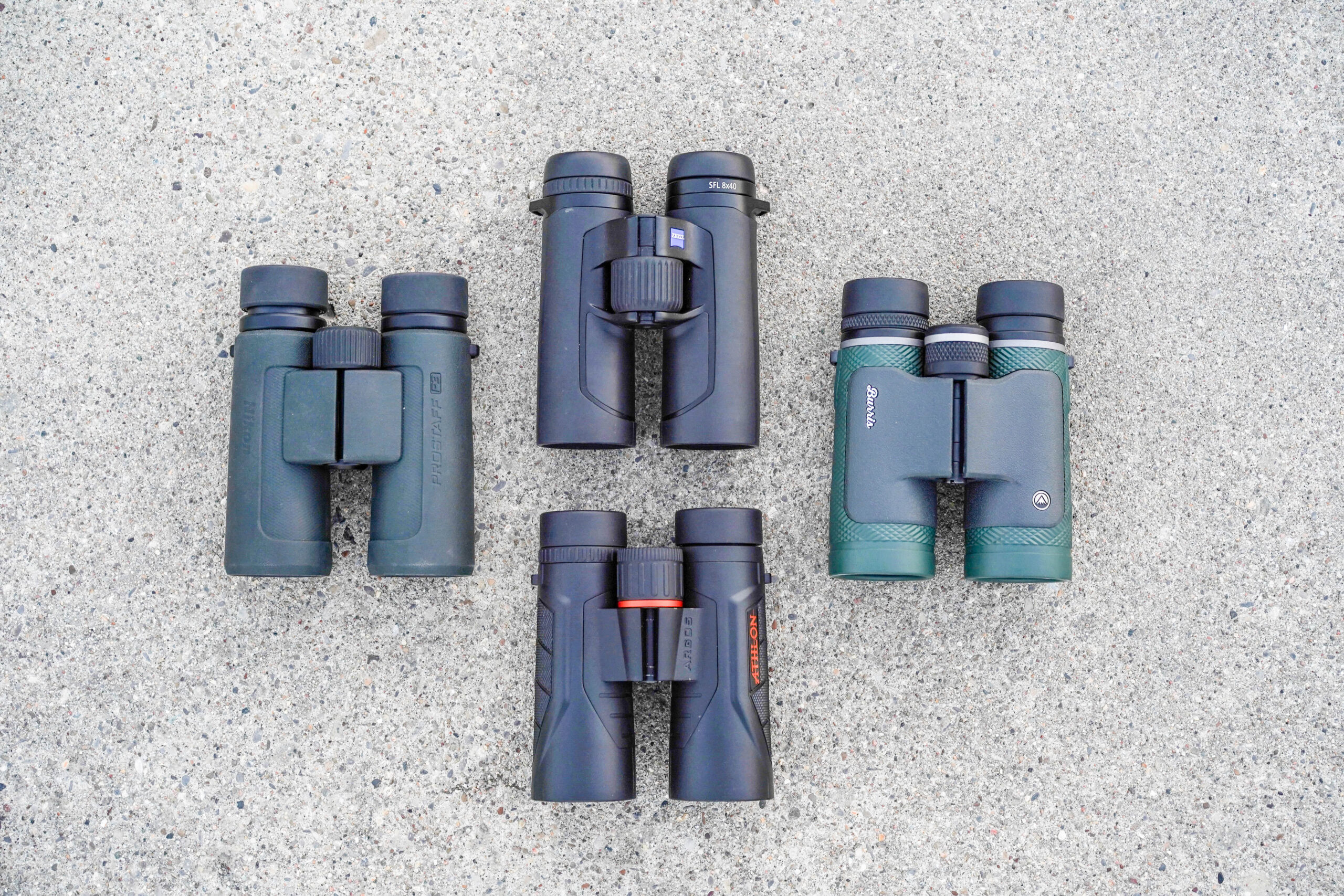
How much more performance do you really get with each additional $100 you spend on a binocular? That was a question that was central to our testers as we worked through our varied field of binoculars. The second question is one that will resonate with anyone who has come off an extended glassing session with sub-standard binoculars and rubbed their tired and strained eyes: how long can you comfortably glass with this binocular.
The answer to the first question is easier to answer. True ED glass probably is twice as good as regular glass, at least in terms of ease of viewing, edge-to-edge clarity, and the lack of distracting flares and sunspots. Same with premium components and a quality build. Put another way, will your $400 binocular last twice as long as a $200 binocular? Based on our assessments of mechanics, durability, and components, our answer is yes. It probably is worth saving up to spend a little more, even at the budget level.
But the second question, which measures duration, is harder to answer. Every pair of eyeballs is different, and to arrive at the answer, you must spend hours behind each binocular. But in many ways, it’s the essential question to ask of a prospective purchase. If the image is bright and clear, and the binocular is easy to hold and fits your face well, then you’ll use it longer, and you’ll consequently spot more birds and animals. The opposite is equally true. A binocular that gives you a headache and makes your eyes water isn’t worth its price.
The only way to find the right binocular that fits both your budget and your eyes is to test each one for extended sessions. Because that’s hard to do in any retail establishment—and even harder for on-line shoppers—we hope our review at least narrows the field for your consideration.
We hope our test also makes you a more informed consumer. Don’t fall for meaningless terms like “HD” or “high-definition” glass or “high performance” optics. Instead, feel how solid and durable an optic feels in your hands, how comfortable it is to glass with, and how amenities like harness and case add value. And lastly, triple check warranty details. Especially with this category of optics, there’s every chance you’ll need it at some point.
Final Thoughts on the Best Binoculars
This is admittedly a partial list, but it’s based on both empirical performance of field-worthy binoculars in the course of our optics testing, and it’s based on our own experience with several of these models. Consider it a good starting point for your own search. The main point: don’t check out one binocular and consider your work done. You’ll want to put several contenders in a head-to-head test and compare and contrast their performance against each other. If you’re still not satisfied, then keep pairing up contenders until you find one that fits your style, particular optical prescription and physical dimensions, and your budget.
